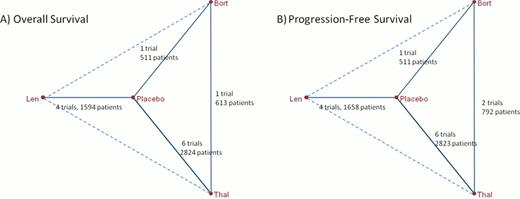Abstract
Abstract 236
There is little consensus on which maintenance therapy clinicians should choose for their patients. Since 1999, the three novel agents of bortezomib, lenalidomide, and thalidomide have been approved for use among patients with MM. These agents have been increasingly used as maintenance therapy. To date, only two randomized controlled trials of maintenance therapy have examined the efficacy of these novel agents head-to-head. Here, we conduct a network meta-analysis of bortezomib, lenalidomide, and thalidomide to determine which of these novel agents could potentially increase overall survival (OS) and progression-free survival (PFS).
A comprehensive literature search of MEDLINE (PubMed), the Cochrane Central Register of Controlled Trials (CENTRAL), and meetings abstracts from American Society of Hematology, American Society of Clinical Oncology, European Society for Medical Oncology and European Hematology Association was undertaken to identify all phase III randomized controlled trials (RCTs) of maintenance therapy published until July 2012. We applied the Bayesian mixed treatment comparison (MTC) method under the random-effects model. The indirect comparisons were constructed from trials that have one treatment in common. For each included RCT, we calculated the hazard ratio (HR) and its corresponding standard error and used this to calculate the indirect estimates of HR and corresponding credible intervals (CrI). We also ranked the treatments according to the probability of best treatment and calculated the surface underneath the cumulative ranking curve (SUCRA). All analyses were conducted in WinBUGS 1.4.3 and Stata 11.2.
The network, number of trials for each comparison, and number of patients enrolled is shown in Figure 1. The network for OS was based on 12 RCTs enrolling 5542 patients and the network for PFS was constructed from 13 RCTs and 5784 patients. The MTC networks were consistent for both OS and PFS. For both OS and PFS, two comparisons were produced (Figure 2). For OS, the analysis showed that none of the treatments were superior. For PFS, lenalidomide was superior to thalidomide (HR = 0.58, 95% CrI [0.37, 0.94]). The estimates of SUCRA and rank probabilities (Figure 3) suggested that for OS bortezomib was best followed by lenalidomide and thalidomide. For PFS, lenalidomide was best followed by bortezomib and thalidomide.
Using the MTC method, we found no evidence that any of the novel agents are superior to one another in terms of OS. Lenalidomide was the only novel agent which was superior to another active therapy (thalidomide). While these results provide preliminary evidence to which novel agent may be more beneficial as maintenance therapy, definitive conclusions cannot be reached until large, well designed RCTs evaluating these therapies head-to-head are conducted.
Direct (solid line) and indirect (dotted line) comparisons, number of trials, and number of patients randomized for OS network (A) and PFS network (B).
Direct (solid line) and indirect (dotted line) comparisons, number of trials, and number of patients randomized for OS network (A) and PFS network (B).
No relevant conflicts of interest to declare.
Author notes
Asterisk with author names denotes non-ASH members.




This feature is available to Subscribers Only
Sign In or Create an Account Close Modal